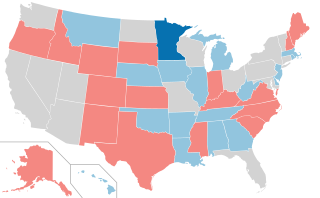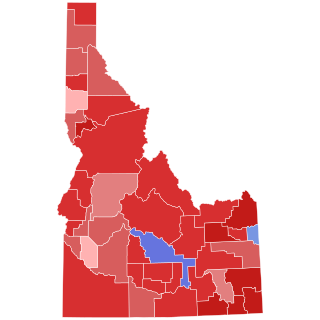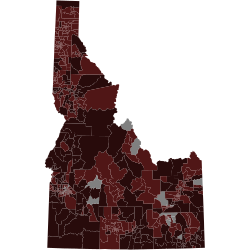
The 2004 United States Senate elections were held on November 2, 2004, with all Class 3 Senate seats being contested. They coincided with the re-election of George W. Bush as president and the United States House elections, as well as many state and local elections. Senators who were elected in 1998, known as Senate Class 3, were seeking re-election or retiring in 2004.

Michael Dean Crapo is an American lawyer and politician serving as the senior United States senator from Idaho, a seat he has held since 1999. A member of the Republican Party, Crapo served as the U.S. representative for Idaho's 2nd congressional district from 1993 to 1999. He is the dean of Idaho's congressional delegation, having served since 1993.

Since Idaho became a U.S. state in 1890, it has sent congressional delegations to the United States Senate and United States House of Representatives, beginning with the 51st United States Congress. Prior to 1890, Idaho sent non-voting delegates to the House of Representatives from 1864 to 1889. Each state elects two senators to serve for six years in general elections, with their re-election staggered. Prior to the ratification of the Seventeenth Amendment in 1913, senators were elected by the Idaho Legislature. Each state elects a varying number of, but at least one, member of the House, depending on population, to two-year terms. Idaho has sent two members to the House in each congressional delegation since the 1910 United States Census.

The 1998 United States Senate elections were held on November 3, 1998, with the 34 seats of Class 3 contested in regular elections. This was seen as an even contest between the Republican Party and Democratic Party. While the Democrats had to defend more seats up for election, Republican attacks on the morality of President Bill Clinton failed to connect with voters and anticipated Republican gains did not materialize. The Republicans picked open seats up in Ohio and Kentucky and narrowly defeated Democratic incumbent Carol Moseley Braun, but these were cancelled out by the Democrats' gain of an open seat in Indiana and defeats of Republican Senators Al D'Amato and Lauch Faircloth. The balance of the Senate remained unchanged at 55–45 in favor of the Republicans.

The 1990 United States Senate elections were held on Tuesday, November 6, 1990, with the 33 seats of Class 2 contested in regular elections. Special elections were also held to fill vacancies. The Democratic Party increased its majority with a net gain of one seat from the Republican Party. The election cycle took place in the middle of President George H. W. Bush's term, and as with most other midterm elections, the party not holding the presidency gained seats in Congress. This was the first time since 1980 that any party successfully defended all their own seats, and the first time Democrats did so since 1958.

The 1984 United States Senate elections were held on November 6, with the 33 seats of Class 2 contested in regular elections. They coincided with the landslide re-election of President Ronald Reagan in the presidential election. In spite of the lopsided presidential race, Reagan's Republican Party suffered a net loss of two Senate seats to the Democrats, although it retained control of the Senate with a reduced 53–47 majority.

The 1980 United States Senate elections were held on November 4, coinciding with Ronald Reagan's victory in the presidential election. The 34 Senate seats of Class 3 were contested in regular elections. Reagan's large margin of victory over incumbent Jimmy Carter gave a huge boost to Republican Senate candidates, allowing them to flip 12 Democratic seats and win control of the chamber for the first time since the end of the 83rd Congress in January 1955. This was the first time since 1966 that any party successfully defended all their own seats.

The 1976 United States Senate elections was an election for the United States Senate. Held on November 2, the 33 seats of Class 1 were contested in regular elections. They coincided with Democrat Jimmy Carter's presidential election and the United States Bicentennial celebration. Although almost half of the seats decided in this election changed parties, Carter's narrow victory did not provide coattails for the Democratic Party. Each party flipped seven Senate seats, although, one of the seats flipped by Democrats was previously held by a Conservative.

The 1972 United States Senate elections were held on November 7, with the 33 seats of Class 2 contested in regular elections. They coincided with the landslide re-election of Republican President Richard Nixon. Despite Nixon's landslide victory, Democrats increased their majority by two seats. The Democrats picked up open seats in Kentucky and South Dakota, and defeated four incumbent senators: Gordon Allott of Colorado, J. Caleb Boggs of Delaware, Jack Miller of Iowa, and Margaret Chase Smith of Maine. The Republicans picked up open seats in New Mexico, North Carolina, and Oklahoma, and defeated one incumbent, William B. Spong Jr. of Virginia.

The 2010 United States Senate elections were held on November 2, 2010, from among the United States Senate's 100 seats. A special election was held on January 19, 2010, for a midterm vacancy in Massachusetts. 34 of the November elections were for 6-year terms to the Senate's Class 3, while other 3 were special elections to finish incomplete terms. Those 37 November elections featured 19 incumbent Democrats and 18 incumbent Republicans.

The 1954 United States Senate elections was a midterm election in the first term of Dwight D. Eisenhower's presidency. The 32 Senate seats of Class 2 were contested in regular elections, and six special elections were held to fill vacancies. Eisenhower's Republican party lost a net of two seats to the Democratic opposition. This small change was just enough to give Democrats control of the chamber with the help of the Independent who at the start of this Congress in January 1955 agreed to caucus with them; he later officially joined the party in April 1955.

The 2004 United States Senate election in Arizona took place on November 2, 2004, alongside other elections to the United States Senate in other states as well as elections to the United States House of Representatives and various state and local elections. Incumbent Republican U.S. Senator John McCain won re-election to a fourth term with his largest victory as a U.S. senator. As of 2025, this was the last time the counties of Apache and Santa Cruz voted for the Republican candidate.

The 2010 United States Senate election in Idaho took place on November 2, 2010, alongside 33 other elections to the United States Senate in other states as well as elections to the United States House of Representatives and various state and local elections. Incumbent Republican U.S. Senator Mike Crapo won re-election to a third term.

The 1998 United States Senate election in Idaho was held November 3, 1998 alongside other elections to the United States Senate in other states as well as elections to the United States House of Representatives and various state and local elections. Incumbent Republican U.S. Senator Dirk Kempthorne decided to retire after one term to run for governor. Republican nominee Mike Crapo won the open seat.

The 2012 United States Senate election in Utah took place on November 6, 2012, concurrently with the 2012 U.S. presidential election as well as other elections to the United States Senate and House of Representatives and as various state and local elections. Incumbent Republican U.S. Senator Orrin Hatch won re-election to a seventh term against the Democratic candidate, former state Senator and IBM executive Scott Howell, in a rematch of the 2000 Senate election,with Hatch doing slightly better than in 2000.. This would be the last time Hatch was elected to the Senate before his retirement in 2018.

The 2016 United States Senate elections were held on November 8, 2016. The presidential election, House elections, 14 gubernatorial elections, and many state and local elections were held concurrently. In the elections, 34 of the 100 seats—all Class 3 Senate seats—were contested in regular elections; the winners served 6-year terms until January 3, 2023. Class 3 was last up for election in 2010 when Republicans won a net gain of 6 seats.

Some type of election in Idaho occurs annually in each of the state's cities and towns, the exact type of which is dependent on the year. Elections for federal and statewide offices occur in even-numbered years, while municipal elections occur in odd-numbered years.

The 2016 United States Senate election in Idaho was held November 8, 2016, to elect a member of the United States Senate to represent the State of Idaho, concurrently with the 2016 U.S. presidential election, as well as other elections to the United States Senate in other states and elections to the United States House of Representatives and various state and local elections. The primaries were held May 17.

A general election was held in the U.S. state of Alabama on November 6, 2018. All Alabama executive officers were up for election along with all of Alabama's seven seats in the United States House of Representatives. Primary elections took place on June 5, 2018 for both major parties.

The 2022 United States Senate election in Idaho was held on November 8, 2022, to elect a member of the United States Senate to represent the state of Idaho. Incumbent Republican Senator Mike Crapo was first elected in 1998 and ran for re-election to a fifth term in office. Primary elections were held on May 17, 2022. Crapo easily won renomination, while former Idaho House of Representatives candidate David Roth won the Democratic primary with 57.8% of the vote. Crapo ultimately won the election, but this was the lowest share of the vote he had ever received for this seat, partially because of an independent candidate, Scott Cleveland, taking away some of his votes.
























